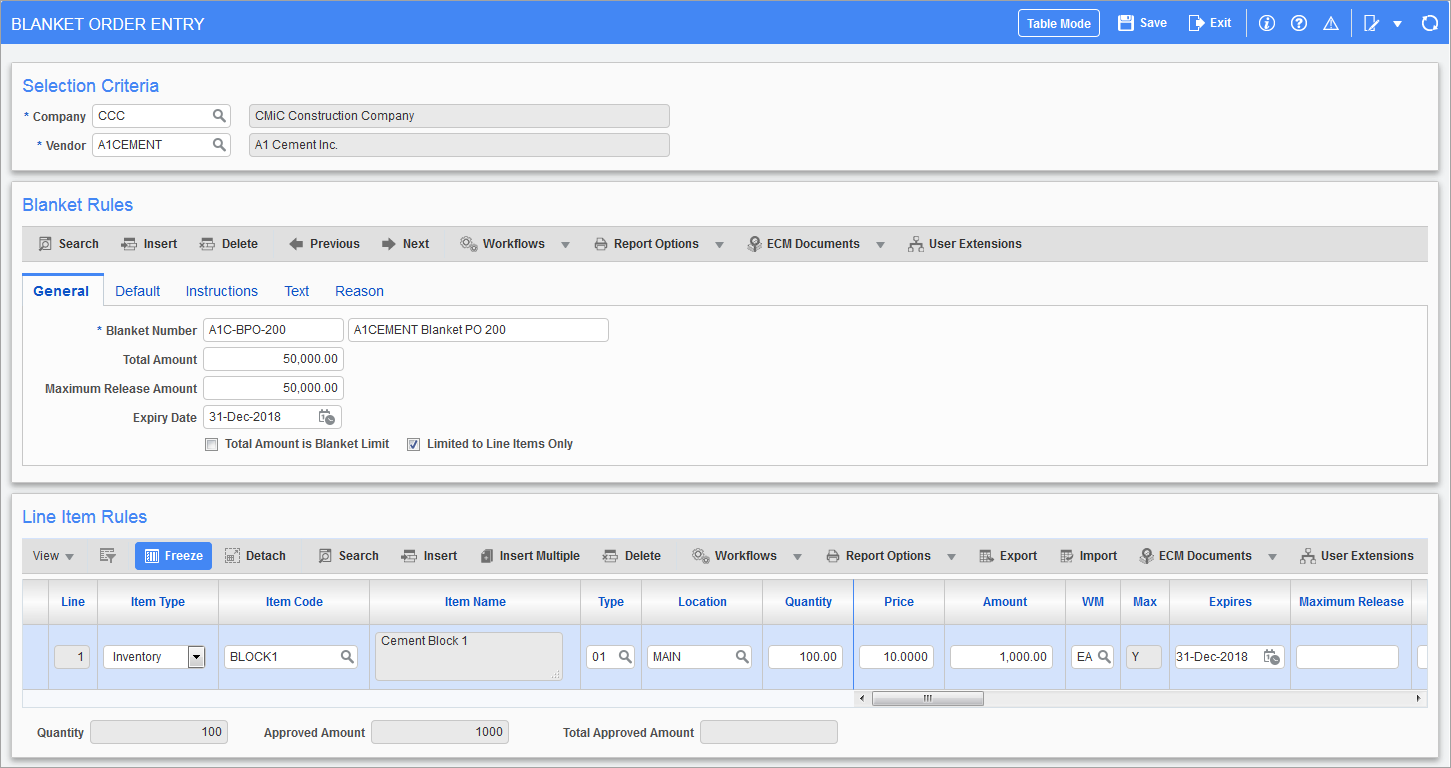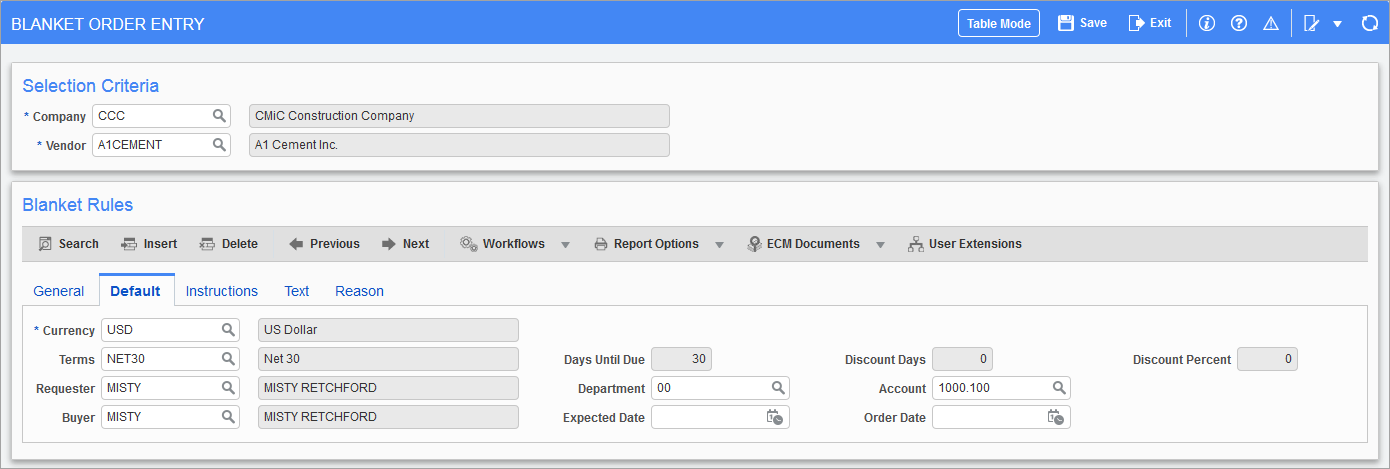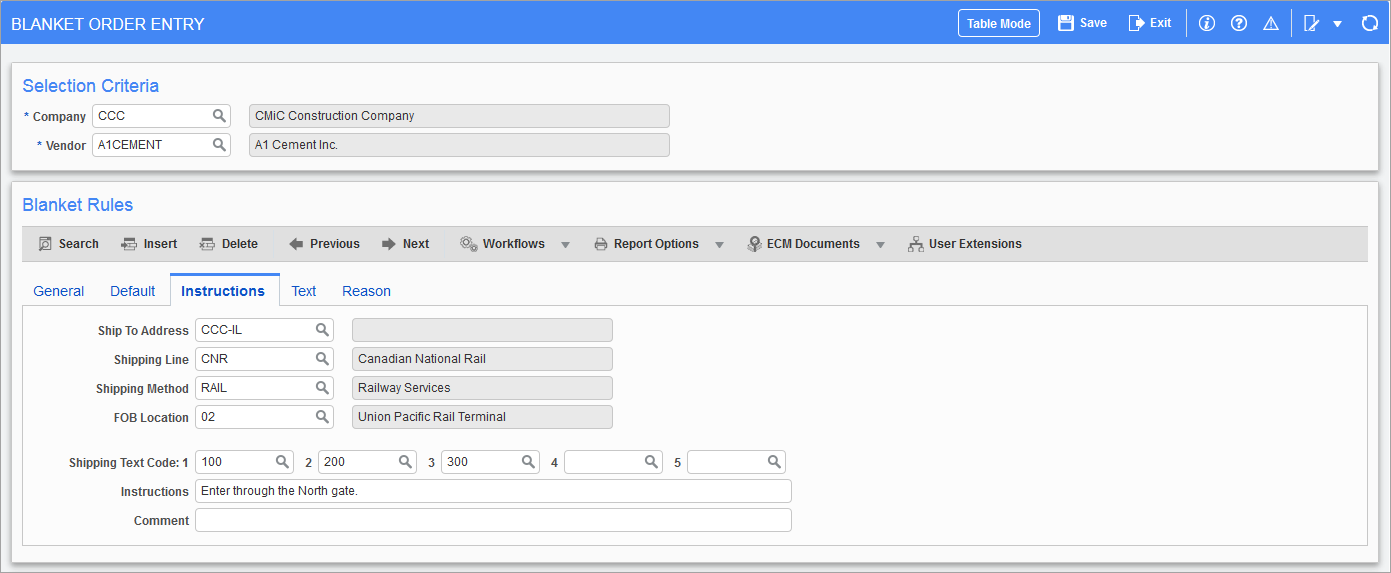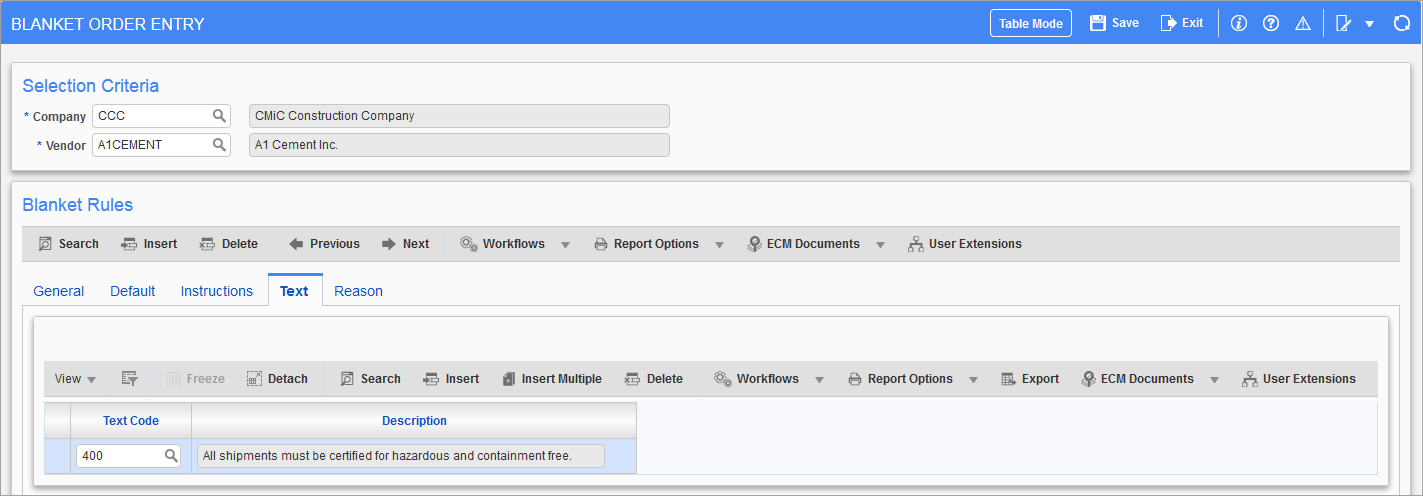
Pgm: POBLENTC – Blanket Order Entry; standard Treeview path: Purchase Order > Setup > Blanket Purchase Order – General tab
Blanket purchase orders are used in situations where there has been an agreement between a company and a vendor, for the vendor to supply the company with specific products at a special price for a specific period of time. Unlike a standard purchase order, the blanket purchase order does not close after it has been used. Once created, all purchases for the products specified on the blanket order will reference the same purchase order number until the agreement expires.
Selection Criteria
Vendor
This field is optional and allows users to query either all available blanket orders or blanket orders from a specific vendor.
Include Expired Blanket Orders – Checkbox
Checking this box gives users the flexibility to access previously expired blanket orders within Table Mode, ensuring historical data remains accessible when necessary.
Blanket Rules
The Blanket Rules section contains the fields, which set the rules for the blanket order being created.
General – Tab
Vendor
The Vendor LOV can be opened to select a vendor from a list of vendors. This field is mandatory to maintain data integrity and ensure accurate purchase processing.
Job Company, Job Code
The Job Company field allows users to select a job’s associated company. The Job Code LOV enables filtering and auto-population based on the selected job company. These fields allow users to associate specific jobs with Blanket Orders.
When a job company is selected, the system enables the user to choose a corresponding Job Code, which automatically populates J-distribution type detail lines. This reduces manual entry errors and enforces consistency across Purchase Order processing.
The system will raise validation if there is a mismatch in job code on the blanket order header and blanket order detail lines. Attempting to change the Job Company or Job Code fields after insertion will result in a mismatch error, ensuring accuracy in financial and operational tracking.
For sub-job handling, if a sub-job exists within the selected job company, users can select it in the Job Code LOV.
Blanket Number
The blanket number is a unique code to both the company and vendor.
-
The blanket purchase order code can consist of a maximum of 11 alphanumeric characters.
-
All lowercase letters will be changed to uppercase.
NOTE: If using a Job Blanket PO Number Mask set up in the Purchase Order Control screen, the user must select a vendor, enter a description in the Blanket Name field, and enter a Job Company and Job Code, then click the [Save] button for the mask to be generated. If the user does not include the job code when saving the entry, the generated mask will default to the regular Blanket PO Numbering Mask set up in the Purchase Order Control screen. For more information, see Purchase Order - Purchase Order Control.
Blanket Name
Enter a descriptive name to identify the blanket purchase order being entered. The blanket purchase order name can consist of a maximum 30 alphanumeric characters
Total Amount
If a total figure is known enter it in this field, however, if there is no limit, enter the total amount of “0”.
-
If the amount entered is “0”, then the Total Amount is Blanket Limit field will become inaccessible.
Maximum Release Amount
Where a value has been entered in the Maximum Release Amount field, purchase order entry will validate that each line item entered against this blanket purchase order does not exceed the maximum amount entered in this field for any single release.
When individual line items do not require validation against the amount released on orders entered against this blanket purchase order, leave this field blank.
Expiry Date
Enter the expiry date of the blanket purchase order. This date must be later than the system date.
The expiry date will be used when determining if the blanket purchase order is open for entry. When selecting a blanket purchase order number within Purchase Order Entry, the system will validate the expiry date against the system date to determine whether the blanket purchase order is valid for entry.
Total Amount is Blanket Limit – Checkbox
Check this box when the approval process is to check that the total of all line items on existing orders do not exceed the total amount specified.
-
If the user has entered “0” in the Total Amount field, this checkbox will not be available.
-
Leave this box blank if the Total Amount field will be used for reference purposes only.
-
The system will leave this field blank as a default.
Limited to Line Items Only – Checkbox
Check the ‘Limited to Line Items Only’ box when no additional items may be added to the order when entering a purchase order. This will limit the order to the items entered on the blanket purchase order. Unchecked additional items may be added at purchase order entry. The system will check this box as a default.
[Create/View Release] – Button
Clicking this button opens the Enter Purchase Order pop-up window, pre-populated with all header information from the corresponding Blanket Order. If an unposted release already exists for the selected Blanket Order, the button will instead open that existing unposted release.
When the user clicks the [Retrieve Blanket PO] button, the system opens the Blanket Order Selection pop-up window allowing the user to select the appropriate line from the available blanket order details. More information can be found in the [Retrieve Entire PO] – Button section of Purchase Order - Enter Purchase Order.
When a new release is created, the WM Code and Currency fields will be disabled to maintain data consistency. Users can complete the release by filling in any additional required fields, assigning approvers if necessary, and then saving or posting the release. All functions mirror the standard process in the Purchase Order Entry (POENTRYC) screen.
When creating a Purchase Order release from a Job-based Blanket Order, the system will automatically default the distribution type to "J". If no job is specified on the blanket, the distribution type will default to "M". This behavior also applies when a Purchase Order is created as a J-type Requisition using a Job-type blanket order. Users still have the flexibility to manually change the distribution type on the PO release screen and can also update the Job/Dept field as needed.
Defaults (for POs) – Tab

Pgm: POBLENTC – Blanket Order Entry; standard Treeview path: Purchase Order > Setup > Blanket Purchase Order – Default tab
This tab is used to enter specific defaults which will default to the Purchase Order Entry screen for POs created through this blanket.
Currency
Enter/select the currency for the blanket purchase order being defined. This field defaults from the vendor, but can be changed if required.
Terms, Days Until Due, Discount Days, Discount Percent
Enter/select a valid vendor term code. Depending on the ‘Use PO Terms’ checkbox setting on the Other tab of the AP Control File setting, the terms entered here will default to the accounts payable voucher when purchase order is selected for payment. The term denotes the standard payment conditions applied to invoices. For example, Cash on Delivery, Net due in 30 days, etc. The terms rules are displayed in the Days Until Due, Days For Discount, and Term Percent fields.
Requester
Enter/select the user requesting the items being purchased.
Requesters are defined within the Purchase Order Roles screen (standard Treeview path: Purchase Order > Setup > Local Tables > Purchase Order Roles). For details, refer to the Purchase Order - Purchase Order Roles
If the ‘Undefined Requestors’ box is checked on the Purchase Order Defaults tab of the PO Control screen (standard Treeview path: Purchase Order > Setup > Local Tables > Control – Purchase Order Defaults), the system will allow the entry of a requestor that has not been defined as a valid user within the Purchase Order module. An undefined requestor will not have an approver defined, and one will have to be manually selected.
Buyer
Enter/select the name of the buyer. Only valid buyers can be selected within this field. Buyers are set up via the User ID Cross-Reference and Purchase Order Roles maintenance screens.
Department/Account
Enter/select the suspense department and account.
Expected Date
Enter/select the date on which the merchandise is expected to be received. It may be the request date or a date set by the vendor.
Order Date
Enter/select the order date. This is a reference date to determine how long a purchase order has been on file and to calculate the expected date the items will actually be received, based on the lead times associated with the items.
Contact
This field is sourced from the same list as POMST_CONTACT_CODE and filtered to display only the contacts associated with the selected vendor.
Instructions (Shipping) – Tab

Pgm: POBLENTC – Blanket Order Entry; standard Treeview path: Purchase Order > Setup > Blanket Purchase Order – Instructions tab
Ship To Address
Enter/select the code for the shipping address of the items defined on the blanket PO. The name, first address line and postal/zip code for the address displays in the adjacent field, if found.
If an address code has been entered on the Purchase Order Control screen in the Default Ship to Address Code field, the code will default into this field (standard Treeview path: PO > Setup > Local Tables > Control – PO Defaults tab).
If the 'Ship To Address Code From Job' box is checked on the Purchase Order Control screen, the Ship To Address field will default from the location address entered on the job.
Shipping Line (Carrier Code)
Enter/select the code for the carrier to be used to transport the items for the blanket PO, if applicable.
The shipping code entered here will default to the PO.
Shipping Method
Enter/select the code for the mode of transportation to be used (motor, rail, air, etc.) for the blanket PO, if applicable.
The shipping code entered here will default to the PO.
FOB Location (Freight On Board Location Code)
Enter/select a valid code for the FOB location for the blanket PO. The descriptive name of the FOB code displays in the adjacent field.
The FOB location entered here will default to the PO.
The FOB location code represents the physical point of delivery where the liability for loss or damage to the goods delivered transfers from the supplier to the purchaser.
Shipping Text Code 1
Enter/select the first text reference code to be printed at the bottom of the PO. Only the text reference codes associated with the shipping text type code defined in the PO Control screen can be selected (standard Treeview path: Purchase Order > Setup > Local Tables > Control – PO Defaults tab).
Shipping Text Codes 2 - 5
Enter/select the second, third, fourth, and fifth shipping text reference code to be printed in the sequence recorded at the bottom of the PO, which describes extra shipping instructions. Only the text reference codes associated with the shipping text type code defined in the PO Control screen can be entered.
Instructions (Shipping)
Enter any distinct shipping instructions for the blanket PO. These instructions will print at the bottom of the PO in the sequence recorded. The instructions can consist of a maximum of sixty (60) alphanumeric characters in length.
Comment
Enter any additional comments about the blanket PO. These comments will not appear on the PO.
Text (Code Details) – Tab

Pgm: POBLENTC – Blanket Order Entry; standard Treeview path: Purchase Order > Setup > Blanket Purchase Order – Text tab
This tab is needed only if the text code for this line item should be different than the one(s) entered on the purchase order header.
Enter/select one or more text codes to set instructions or messaging for the line item.
NOTE: Only those text codes associated with the shipping instruction text type entered on the Purchase Order Control screen will be available for use.
Reason (for Blanket PO) – Tab

Pgm: POBLENTC – Blanket Order Entry; standard Treeview path: Purchase Order > Setup > Blanket Purchase Order – Reason tab
Enter the reason for the creation of the blanket PO, if required.
Line Item Rules
This section is used to associate the item type, item, quantity, weight measure, distribution types and price maximum with the blanket purchase order.
Line
PO detail line number. This number is automatically generated.
Item Type
Select the item type from the drop-down menu. Options are “Inventory”, “Non-Stock”, and “Free-Form”.
Inventory items apply to merchandise ordered from a vendor or manufactured in-house, which will be tracked within the Inventory module.
Non-stock items apply to merchandise ordered from a vendor or manufactured in-house which will not be tracked within the Inventory module.
A free-form item is merchandise that is being purchased on a one-time only basis.
Item Code
Enter/select the item code for the item type selected in the previous field.
For inventory items, the list of available inventory item codes includes class codes.
For non-stock items, the list will show non-stock items previously set up in the PO Non-Stock Item Maintenance screen (standard Treeview path: Purchase Order > Setup > Non-Stock Items).
For free-form items, users can manually enter a user-defined code in the Item Code field and a user-defined name in the Item Name field. The item name description allows for 2000 characters.
Type (Item Type Code)
Item type codes are for inventory items only and have been set up in the inventory module.
If the item is an inventory item, enter/select the item type code. The item type is used in conjunction with the inventory item to identify the inventory value and posting controls to be used during the inventory processing.
Location (Storage Location)
If the item is an inventory item, enter/select the storage location.
This field is required for inventory items only. The storage location is set up in the inventory module and assigned to the item via Item Detail in the inventory module. This field will be disabled for either non-stock or free-form items.
Quantity, WM
Enter the quantity for the specified Item to be purchased along with its weight measurement.
Price
(Optional) Enter the price per unit (based on the weight measure code) for the line item being defined. If the item is a non-stock item, the price will default from the PO Non-Stock Item Maintenance screen.
Amount (Total)
(Optional) Enter the total amount of the blanket purchase order for this line item.
If both price and quantity have been entered for this line item, then the total amount will automatically display as the price multiplied by the quantity, and will not be available for editing.
Previously Released Amount
This shows the cumulative monetary value of all previously posted releases against the blanket order. By default, the Previously Released Amount column appears just after the Amount column.
Max (Maximum Flag)
Enter a “Y” in this field for purchase order entry to validate that when this item is selected, the quantity ordered does not exceed the quantity entered here. The Max field is for the line item only and will have to be set for each line entered.
Enter an “N” in this field if it is not required for purchase order entry to validate the quantity ordered against this line item.
Previously Released Quantity
This column displays the total quantity from all previously posted releases against the blanket order. By default, the Previously Released Quantity column appears immediately after the Maximum Quantity column.
Expires (Expiry Date)
(Optional) If an expiry date has been entered in the Blanket Rules section, it will default into this field. The defaulted date can now be deleted or changed on a line-by-line entry. If the date is being changed, it must be later than the system date.
If no expiry date was entered in the Blanket Rules section, the field will return as null. It may be left as such or a date may be added on a line-by-line entry.
Maximum Release
Enter maximum release.
DT (Distribution Type (DT) Code)
Enter “G” if the charges for this purchase order should distribute directly to a G/L account.
Enter “J” if the charges for this purchase order should distribute to a job element.
Enter an “E” if the charges for this purchase order should distribute to an equipment element.
Enter an 'I' if the charges for this purchase order should update the inventory.
The other headings and fields in this section will change according to the distribution code entered.
For a ‘G’ distribution
Enter the department and account code to be affected by this distribution.
For a ‘J’ distribution
The department will default from the accounts as entered on the Job Maintenance screen. The General Ledger account associated with this job is derived from either the job or the category code.
Enter the job/cost code and category combination required.
For an ‘E’ distribution
The department will default from the equipment’s home location as entered on the Equipment Maintenance screen. The General Ledger account associated with this equipment item is derived from the transaction code.
Enter the equipment, category and transaction code as required.
NOTE: Only equipment items with a commission date on or after the transaction date of entering the blanket purchase order will be available.
When using an ‘I’ distribution
The cursor will skip directly to the ship code field, as all relevant posting information will come from the inventory item itself.
Enter/select the location code where location codes are being used to record a different shipping address for a specific line.
Tax 1, Tax 2, Tax 3
The tax codes will have defaulted from the inventory item or vendor. Tax 1, 2 or 3 can be left as per the default or changed on a line-by-line entry.
Text Code
Enter/select a text reference code to supply an instruction and/or message pertaining to the specified Item. Only those text codes which apply to the shipping instruction text type entered on the Purchase Order Control screen will be made available in this field.
This field is needed only if the text code for this line item should be different than the one entered on the Instructions tab of the purchase order header.
Description (Line Description)
Enter a specific description for the line item, if required. The description field may consist of a maximum of 60 characters.
NOTE: If the item is a free-form item, and the free-form description has a carriage return preceding the actual description text, it may generate an error during purchase order processing.
NOTE: Blanket PO Entry does NOT allow ‘W’ type distributions, as there may not be a business requirement of a blanket PO for a Preventive Maintenance work order. Use the PO Entry screen which allows ‘W’ type distributions.